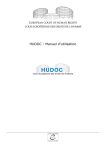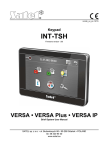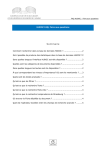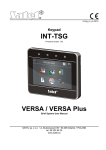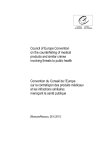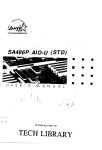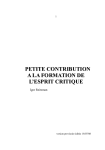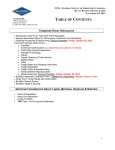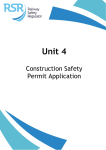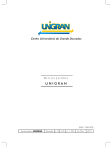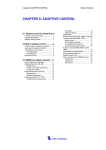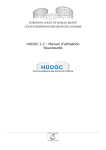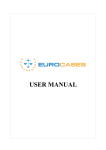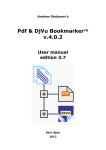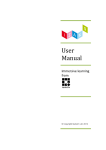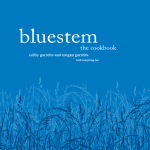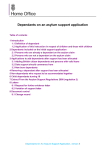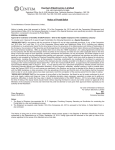Download HUDOC User Manual 1.0
Transcript
HUDOC User Manual
HUDOC Manual
Contents
I.
II.
III.
IV.
About the database .........................................................................4
Interface languages ........................................................................4
Document collection .......................................................................5
Simple search .................................................................................6
A.
B.
C.
Search syntax .............................................................................................6
Simple Boolean Search screen .......................................................................7
Word suggestions.........................................................................................8
V.
Narrowing your search ...................................................................9
A.
Filters.........................................................................................................9
B.
C.
1.
Language ......................................................................................10
2.
Importance....................................................................................11
What do we mean by texts analysed by importance level? ...............................12
3.
State ............................................................................................12
4.
Article ...........................................................................................13
5.
Non-violation .................................................................................14
6.
Violation........................................................................................14
Keywords ..................................................................................................15
More filters ................................................................................................18
1.
2.
3.
4.
5.
Date .............................................................................................18
Courts...........................................................................................19
Judges ..........................................................................................19
Originating Body.............................................................................19
Organisation ..................................................................................20
VI.
Advanced Search ..........................................................................20
A.
B.
C.
D.
E.
F.
G.
Text .........................................................................................................21
Case Title ..................................................................................................21
Application Number ....................................................................................22
Strasbourg Case-law...................................................................................22
Rules of Court............................................................................................22
Applicability ...............................................................................................22
Conclusion.................................................................................................23
H.
I.
J.
K.
L.
M.
N.
1.
Conclusions of Judgments ................................................................23
2.
Conclusions of Decisions ..................................................................24
3.
Conclusions of Communicated Cases .................................................25
4.
Conclusions of Interim Resolutions ....................................................25
5.
Conclusions of Final Resolutions........................................................25
Resolution Number .....................................................................................25
Date .........................................................................................................25
Separate Opinion(s) ...................................................................................26
Domestic Law ............................................................................................26
International Law & Other Relevant Material ..................................................26
Keywords ..................................................................................................26
Search in document sections........................................................................27
VII. How to sort your results ...............................................................28
HUDOC Manual
VIII. The results list screen ...................................................................29
A.
Viewing search results ................................................................................30
B.
1.
2.
3.
Viewing
Print .............................................................................................31
Export...........................................................................................31
RSS ..............................................................................................31
documents.....................................................................................31
C.
D.
E.
F.
G.
1.
2.
3.
4.
5.
6.
7.
Viewing
Viewing
Viewing
Viewing
Viewing
Viewing a document in web (HTML) format ........................................31
Opening and downloading the PDF version of the original document ......32
Opening and downloading a Word copy of the original document...........32
Document URL ...............................................................................33
Maximising and minimising the view of the document ..........................33
Sending a link to the document ........................................................33
Printing the document .....................................................................33
the Case Details .............................................................................33
Language Versions..........................................................................34
Related documents .........................................................................35
the Legal Summaries ......................................................................36
Press Releases ...............................................................................40
IX.
The toolbar ...................................................................................45
A.
Help .........................................................................................................45
HUDOC Manual
I.
About the database
The European Court of Human Rights (ECHR) Portal is a powerful, modern, user-friendly
information system.
The HUDOC database provides access to the case-law of the European Court of Human
Rights (Grand Chamber, Chamber and Committee judgments, decisions, communicated
cases, advisory opinions and legal summaries from the Case-Law Information Note), the
European Commission of Human Rights (decisions and reports) and the Committee of
Ministers (resolutions).
These texts can be consulted via a sophisticated yet easy-to-use search screen.
To ensure the most efficient use of the database as a research tool, the Portal is updated
regularly.
II.
Interface languages
The Portal is available in English and French interfaces.
Last Grand Chamber
and Chamber
judgments by
default
4
HUDOC Manual
III.
Document collection
You can narrow your search by document collection.
On the left-hand side of the screen you
can choose which case-law collections
you want to search in.
Please note that the default collection
to search is JUDGMENTS of the Grand
Chamber and Chamber. To search in
other collections such as DECISIONS,
tick the appropriate box.
Number of documents
in brackets
The case-law of the Convention institutions has been split into separate document
collections, which can be searched either individually or together – Judgments (Grand
Chamber, Chamber and Committee), Admissibility and Screening Panel Decisions,
Communicated Cases, Advisory Opinions, Reports and Resolutions of the
Committee of Ministers.
Legal Summaries are extracted from the Court's Case-law Information Note. The
Registry summarises cases which it considers to be of particular interest. These
summaries are not binding on the Court. Each summary is linked to the corresponding
Communicated Case, Decision or Judgment. It is classified by the Convention Article(s)
to which the case relates and by keywords, and comprises a descriptive headnote, a
concise presentation of the facts and a presentation of the law, with the emphasis on
points of legal interest.
New documents are added regularly to the Portal. At present, the availability of
documents on the Portal is as follows:
Court
Court
Court
Judgments / Admissibility decisions (November 1998 →)
Judgments / Screening Panel decisions (1959-October 1998)
Communicated Cases
Commission
Commission
Commission
Admissibility decisions (1986 →)
Admissibility decisions (1955 - 1986)
Reports (public only)
Committee of Ministers
Committee of Ministers
Resolutions (execution)
Resolutions (merits)
ALL
ALL
12/12/2011 →
ALL
some published decisions
1963 →
1972 →
From 1959 to July 2004
Please note that the default collection to search is JUDGMENTS of the Grand Chamber
and Chamber. To search in other collections such as DECISIONS, tick the appropriate
box.
The number of documents in each collection is indicated in brackets.
5
HUDOC Manual
For example (see screenshot above): Chamber (30475)
IV.
Simple search
Use this field to perform a search in one or more collections.
You can perform a search by entering a single word, a phrase, a group of words, a case
title, an application number, a State, a Boolean phrase, etc.
Click on
to perform the search.
A. Search syntax
To assist you in carrying out searches, the table below details the many different types
of search syntax that the Portal understands and provides practical examples of their
use.
ECHR Portal Boolean Searching Syntax
Search
parameter
Meaning
Examples, i.e. what to
type in the 'Text' field
Word
A sequence of one or more adjacent letters or
numbers.
Burglary
Constitution
Phrase /
sentence /
paragraph
Groups together words in the order you wish to
find them – phrase searching – “word word"
"prison sentence"
"Court of Cassation"
"Law no. 65-543"
AND
Finds documents containing both terms in any
order – word AND word, or phrase AND word, or
phrase AND phrase, etc.
police AND violence
"hot water" AND prison
OR
Finds documents containing either of the two
terms – word OR word, or phrase OR word, or
phrase OR phrase.
violence OR cruelty
police OR army
"hot water" OR prison
NOT
Finds documents that do not contain the specified
term – word NOT word, or phrase NOT phrase
NOT television
Police NOT prison
Proximity
Finds documents in which the specified terms are
near each other – word NEAR word, or phrase
NEAR word, or phrase NEAR phrase.
violence NEAR damage
"hot water" NEAR prison
6
HUDOC Manual
Precedence
Multiple
character
wildcard
Single
character
wildcard
Finds documents in which the specified terms,
although not necessarily together, must appear in
the specified order – { word word}
Replaces any number of missing letters - *ab, a*b,
or ab*
{radio television}
{hearing conviction}
violat*
(violation, violate, violates,
violated, violator, violating
etc.)
violate?
(violated, violates)
Replaces any single letter - a?b
For example,
Combinations of the above search criteria are also possible.
B. Simple Boolean Search screen
You can also open the Simple Boolean Search screen by clicking on the arrow:
Open the simple Boolean
search screen by clicking
on the arrow
The simple Boolean search screen
Click on OK to
confirm your query
Click on Cancel to
cancel your query
Click on Clear to
clear your query
The screen offers you five possibilities:
-
This exact word or phrase is a phrase search.
If you enter Court of Cassation the system will search for "Court of Cassation".
-
All of these words is an AND search.
If you enter police violence the system will search for police AND violence.
-
Any of these words is an OR search.
If you enter police violence the system will search for police OR violence.
-
Not any of these words is an NOT, AND NOT search.
If you enter police violence you will search for NOT police AND NOT violence.
7
HUDOC Manual
-
The 'Boolean search' field allows you to manually enter Boolean terms if you are
more comfortable with that. Please refer to the ECHR Portal Boolean Searching
Syntax table above (page 5).
C. Word suggestions
If you make a mistake in the spelling of a word, the search will not return any results.
However, it will suggest that you make sure all words are spelled correctly, try different
search terms or try more general search terms.
If there is one, it will also suggest a word. You can click on the suggestion in blue and
search for it.
Example:
Violance
Wrong spelling of
the word 'violence'
Suggestion of the
word 'violence'
8
HUDOC Manual
V.
Narrowing your search
A. Filters
The filter panel on the lefthand side of the screen helps
you to narrow your search
Click on '?' for a definition of the filter
Number of documents
in brackets
You can very easily narrow your search using the filters. The results screen will be
modified each time you use a filter.
Your chosen filters will be listed in the criteria bar.
Example: Judgments (Grand Chamber and Chamber), Language: English, Importance:
1, State: United Kingdom, Non-violation of Article 8.
9
HUDOC Manual
Number of results
Clear all criteria
Remove this
filter by
clicking on 'x'
Criteria
bar
Remove this
filter by
clicking on 'x'
Filter reduced
to the choice
made
More…
Filters can be easily added or removed by clicking on the
button in the criteria bar or
the
button in the filter on the left-hand side of the screen.
The filters are as follows: 'Language', 'Importance', 'State', 'Article', 'Non-violation' and
'Violation'.
The number of documents for each filter is indicated in brackets.
1.
Language
Use the Language filter to search by document language.
Please note: The Court is only responsible for French and English texts translated by the
Registry. It accepts no responsibility for the quality or content of translations into nonofficial languages, and their appearance in HUDOC does not amount to an endorsement
by the Court.
This filter is displayed in descending order of the number of documents in each
language.
When you click on More…, a box will show you the complete list of languages available
in alphabetical order with the number of documents in brackets.
10
HUDOC Manual
To sort your results language
Tick the box to select a language.
See the number of documents by
language inside the brackets
bracketsImportance level. You
can select one or more
Importance level.
To close the Language box
To confirm the selection of language(s)
You can sort the Language filter by:
- alphabetical order
- reverse alphabetical order
- number of results in descending order
- number of results in ascending order.
2.
Importance
The Importance filter can be used to make searches of judgments, decisions and/or
advisory opinions classified by level of importance.
Cases are divided into four categories, the highest level of importance being Case
Reports, followed by levels 1, 2 and 3. The classification by levels 1, 2 and 3 remains
provisional until the Bureau has decided whether a case should appear in the Court's
official reports series. These Bureau decisions are published on the Court's website under
'Case-Law'. For example, a case that was tentatively classified as level 1 but ultimately
selected for the official reports will change category.
Case Reports: Judgments, decisions and advisory opinions delivered since the inception
of the new Court in 1998 which have been published or selected for publication in the
Court's official Reports of Judgments and Decisions. The selection from 2007 onwards
has been made by the Bureau of the Court following a proposal by the Jurisconsult.
Judgments of the former Court (published in Series A and Reports) and cases published
in the former Commission's Decisions and Reports series have not been included in the
Case Reports category and are therefore classified by levels 1, 2 and 3 only.
1 = High importance: All judgments, decisions and advisory opinions not included in
the Case Reports which make a significant contribution to the development, clarification
or modification of the Court's case-law, either generally or in relation to a particular
State.
11
HUDOC Manual
2 = Medium importance: Other judgments, decisions and advisory opinions which,
while not making a significant contribution to the case-law, nevertheless go beyond
merely applying existing case-law.
3 = Low importance: Judgments, decisions and advisory opinions of little legal
interest, namely judgments and decisions that simply apply existing case-law, friendly
settlements and strikeouts (unless raising a particular point of interest).
This filter is displayed in descending order of the number of documents in each
importance level.
When you click on More… the importance level filter is displayed by category in
descending order of importance.
You can sort the Importance filter by:
- alphabetical order
- reverse alphabetical order
- number of results in descending order
- number of results in ascending order.
What do we mean by texts analysed by importance level?
Owing to the large number of cases concerned, from 2007 onwards only limited
analytical information is available in respect of judgments and decisions of lesser interest
in terms of the Court's case-law (importance level 3).
For importance 3 judgments and decisions delivered from 1 January 2007 onwards only
the following fields are operational for searches concerning this category:
- Case Title
- Application Number
- State
- Article
- Keywords
- Conclusion
- Text
- Importance level
Only cases of importance levels 1 and 2 contain a full analysis and can be searched
under all the fields.
3.
State
Use the State filter to search for cases against a particular country or countries.
The filter is displayed in descending order of the number of documents containing the
respondent State or States.
12
HUDOC Manual
When you click on More… the list of States is displayed in alphabetical order.
You can sort the State filter by:
- alphabetical order
- reverse alphabetical order
- number of results in descending order
- number of results in ascending order.
4.
Article
Use the Article filter to search by the Convention or Protocol Article(s) concerned in a
case.
Simply follow the format in the table below to filter by Article:
To search for
Article 8
Article 5 § 2
Article 6 § 3 d)
Article 2 of Protocol No. 1
Article 14 in conjunction with Article 3
Select
8
5-2
6-3-d
P1-2
14+3
This filter is displayed in descending order of the number of documents containing the
Article.
When you click on More… the list of Articles is displayed in order of their appearance in
the Convention and additional Protocols.
Number of documents by Article
Tick the box to select an Article.
You can select one or more Articles.
To confirm the selection of Article(s)
You can sort the Article filter by:
- alphabetical order
- reverse alphabetical order
- number of results in descending order
- number of results in ascending order.
13
HUDOC Manual
5.
Non-violation
Use the Non-violation filter to search for judgments (Grand Chamber, Chamber and
Committee) in which the Court found no violation of the Convention or Protocol Article(s)
indicated.
This filter is displayed in descending order of the number of documents containing a
finding of no violation of the Article(s) in question.
Examples: select 8 to find cases in which there was a finding of no violation of Article 8
of the Convention. Select P1-3 to find cases in which there was a finding of no violation
of Article 3 of Protocol No. 1.
When you click on More… the non-violation filter is displayed in the order of appearance
of the Articles of the Convention and additional Protocols.
Number of documents by Article
Tick the box to select an
Article. You can select one or
more Articles.
To confirm the selection of Article(s)
You can sort the Non-violation filter by:
- alphabetical order
- reverse alphabetical order
- number of results in descending order
- number of results in ascending order.
6.
Violation
Use the Violation filter to search for judgments (Grand Chamber, Chamber and
Committee) in which the Court found a violation of the Convention or Protocol Article(s)
indicated.
This filter is displayed in descending order of the number of documents containing a
finding of a violation of the Article(s) in question.
14
HUDOC Manual
Examples: select 8 to find cases in which there was a finding of a violation of Article 8 of
the Convention. Select P1-3 to find cases in which there was a finding of a violation of
Article 3 of Protocol No. 1.
When you click on More… the list of violations is displayed in the order of appearance of
the Articles of the Convention and additional Protocols.
You can sort the Violation filter by:
- alphabetical order
- reverse alphabetical order
- number of results in descending order
- number of results in ascending order.
B. Keywords
You can narrow your search using the keywords.
Use the Keywords filter to search for documents with similar legal content (keywords
are linked to the Court's reasoning and conclusions).
The Keywords filter is displayed in descending order of the number of documents
containing the keyword in respect of the Article indicated.
On the left-hand side of the
screen you can narrow your
search with keywords.
Number of documents
in brackets
More…
When you click on More… the list of keywords is displayed by Article in the order of
appearance of the Articles of the Convention and additional Protocols.
There are two main ways to locate a keyword:
First, by navigating through the hierarchy via the and icons.
Second, by entering a search term in the field at the top of the window and performing a
search of the entire hierarchy.
15
HUDOC Manual
Keyword search field
Tick the box
To confirm the
selection of
keywords
Link to the list
of keywords by
Article
You can enter a keyword in the search field and click on the
button. The
keyword will be highlighted in red and the number of results found will be displayed.
For example: torture
Searching for torture
Keywords related to torture in red
Tick the box
You can select one or more keywords by ticking the box to the left of the keyword. Once
you have made your selection click on the
button to confirm.
TIP
Other information concerning keywords can be found in the Keywords section under
Advanced Search, page 25.
16
HUDOC Manual
Each keyword in the hierarchy can contain 'child' keywords which are directly related to
the 'parent' keyword. By clicking the icon next to a keyword you can view any child
keywords.
You can click on the
icon to contract a keyword and hide any child keywords.
For example, in the case of Article 10:
'Parent' keyword
'Child' keywords
A list of keywords has been assigned to each Article of the European Convention on
Human Rights and its Protocols. The list will help you use the keywords effectively. It
supplements the list available via the Keywords lookup on the HUDOC search portal,
which is arranged in alphabetical order
(http://www.echr.coe.int/ECHR/EN/HUDOC/keywords).
17
HUDOC Manual
C. More filters
You can further narrow your search by using More Filters.
These additional filters are: 'Date', 'Courts', 'Judges', 'Originating Body' and
'Organisations'.
The number of documents for each filter is indicated in brackets.
These filters are displayed by default in descending order of the number of documents.
1.
Date
Use the Date filter to search by period.
Examples: Last Week; Last 5 Years, etc.
This filter is displayed in ascending order of the number of documents by period.
18
HUDOC Manual
2.
Courts
Use the Courts filter to search by international courts and national courts of the 47
Council of Europe member States mentioned in the texts.
Examples: Cour de cassation, Supreme Court, etc.
This filter is displayed in descending order of the number of documents by court.
When you click on More… the courts are displayed in alphabetical order.
You can sort the Courts filter by:
- alphabetical order
- reverse alphabetical order
- number of results in descending order
- number of results in ascending order.
3.
Judges
Use the Judges filter to search for cases where a particular judge from the Court or a
member of the Commission is mentioned in the text.
Examples: Christos Rozakis, Nicolas Bratza, etc.
The filter is displayed in descending order of the number of documents containing the
judge's name.
When you click on More… the judges' names are displayed in alphabetical order.
You can sort the Judges filter by:
- alphabetical order
- reverse alphabetical order
- number of results in descending order
- number of results in ascending order.
4.
Originating Body
Use the Originating Body filter to search for documents emanating from a specific
organ of the Court or Commission or from the Committee of Ministers.
Examples: COMMISSION (Plenary), Committee of Ministers, Court (First Section), etc.
This filter is displayed in descending order of the number of documents by originating
body.
When you click on More… the Originating Body filter is displayed in alphabetical order.
You can sort the Originating Body filter by:
- alphabetical order
- reverse alphabetical order
- number of results in descending order
- number of results in ascending order.
19
HUDOC Manual
5.
Organisation
Use the Organisation filter to search by national and international organisations
mentioned in the texts.
Examples: European Central Bank, Council of Europe, Air Canada, etc.
This filter is displayed in descending order of the number of documents containing
references to the national and international organisations.
When you click on More… the Organisations filter is displayed in alphabetical order.
You can sort the Organisation filter by:
- alphabetical order
- reverse alphabetical order
- number of results in descending order
- number of results in ascending order.
VI.
Advanced Search
Click on
to open the Advanced Search screen.
The Advanced Search screen is composed of different search fields:
Place your mouse on
'?' for a definition of
the search field
Click here to display
the Keywords list
Click here to perform
the search
You can find a definition of each field by placing your mouse over the question mark
.
For example:
20
HUDOC Manual
You can do a combined search of two or more search fields.
For example:
In this example the search has been focused on the
word prison (Text field); from 03/01/2011 to
10/05/2012 (Date); and (Art. 2-1) Life (Keyword).
A. Text
Use the Text field to perform a free text search in one or more collections.
Entering terms in the Text box carries out a search for a particular "item" in the main
text of a document, whether it be a single word, a phrase, a sentence, etc.
In addition to the simple search defined above you can use the Portal to carry out much
more complex searches.
TIP
More information concerning Text search can be found in the Search Syntax and Simple
Boolean Search Screen sections under Simple Search, page 5 and 6.
B. Case Title
Use the Case Title field to search by the name of the case. Type any part of the case
title in the box and click on the case you are looking for from the list of suggestions.
Examples: boulois; hatton
21
HUDOC Manual
C. Application Number
Use the Application Number field to search by the application number of the case.
Type any part of the application number in the box and click on the number you are
looking for from the list of suggestions.
Example: 3394/03
D. Strasbourg Case-law
Use the Strasbourg Case-law field to search for judgments and decisions (Importance
'Case Reports', 1 and 2) in which a particular Court or Commission case has been cited.
Example: typing 'Hatton' or '36022/97' in this field will return all cases in which the
Hatton v. United Kingdom judgment was cited.
TIP
To view the Strasbourg case-law associated with a case from the HUDOC case-law
collection, open the Case Details page (for more information see 'Viewing the Case
Details' below, page 33).
E.
Rules of Court
Use the Rules of Court field to search for cases (Importance 'Case Reports', 1 and 2)
containing references to the Court's procedural rules. Only the Rule number should be
entered in the field.
Examples: 39; 53-4
TIP
To view the Rules of Court associated with a case from the HUDOC case-law collection,
open the Case Details page (for more information see 'Viewing the Case Details' below,
page 33).
F.
Applicability
Use the Applicability field to search for cases (Importance 'Case Reports', 1 and 2) in
which the question of the applicability of a particular provision of the Convention or
Protocols has been raised.
Examples: Art. 8 applicable; Art. 8 inapplicable; P1-1 applicable; P1-1 inapplicable; Art.
6 discussed
TIP
To view the applicability data associated with a case from the HUDOC case-law
collection, open the Case Details page (for more information see 'Viewing the Case
Details' below, page 33).
22
HUDOC Manual
G. Conclusion
A number of documents in the HUDOC collection contain a brief summary of the outcome
of the case, for example whether there was a violation of the Convention and whether
any award was made in respect of damage. Below are some examples of conclusions
included on the Portal:
-
Violation of Article 6-1
Pecuniary damage - award
No violation of Article 14+8
Struck out of the list
Use the Conclusion field to search according to the outcome of a case.
Examples: Violation; No violation; Admissible; Inadmissible; Remainder inadmissible
To help you in your search, the lists below list all the possible types of conclusions:
1.
Conclusions of Judgments
Preliminary objections:
Preliminary
Preliminary
Preliminary
Preliminary
Preliminary
Preliminary
Preliminary
Preliminary
Preliminary
Preliminary
Preliminary
Preliminary
Preliminary
Preliminary
Preliminary
Preliminary
Preliminary
objection allowed (x)
objections allowed (x ; x)
objection partially allowed
objections partially allowed
objection dismissed (x)
objections dismissed (x ; x ; x)
objection partially dismissed (x)
objections partially dismissed (x ; x ; x)
objection joined to merits (x)
objections joined to merits (x ; x)
objection joined to merits and dismissed (x)
objections joined to merits and dismissed (x ; x ; x)
objection partially joined to merits and dismissed (x)
objections partially joined to merits and dismissed (x ; x ; x)
objection not necessary to examine (x)
objections not necessary to examine (x ; x ; x)
objection withdrawn (x)
Admissibility:
Remainder inadmissible
Loss of victim status
Inapplicable
Lack of jurisdiction
Struck out of the list
Revision admitted
Revision rejected
23
HUDOC Manual
Violation / No violation:
Violation/No
Violation/No
Violation/No
Violation/No
Violation/No
violation
violation
violation
violation
violation
of
of
of
of
of
Article
Article
Article
Article
Article
z
z+z
14+z
1 of Protocol No. 1
z read in the light of Article z
TIP
Depending on the case, we add the following information: substantive or procedural
aspect, potential violation/non-violation, the State against which a violation or no
violation has been found, the State to which the applicant is liable to be or has been
expelled or extradited, etc.
For example: No violation of Article 3 - Prohibition of torture (Article 3 - Expulsion)
(potential) (Serbia)
Just satisfaction and execution of judgments:
Damage - claim dismissed
Damage - award
Pecuniary and non-pecuniary damage - award
Pecuniary damage - claim dismissed
Pecuniary damage - award
Pecuniary damage – reserved
Pecuniary damage - finding of violation sufficient
Pecuniary and non-pecuniary damage - finding of violation sufficient
Respondent State to take individual measures
Respondent State to take measures of a general character
Interpretation
Non-pecuniary damage - claim dismissed
Non-pecuniary damage - award
Non-pecuniary damage - finding of violation sufficient
Non-pecuniary damage - reserved
Reopening of case
Restitution of the disputed property or financial award
Just satisfaction partially reserved
Just satisfaction dismissed (out of time)
Just satisfaction reserved
2.
Conclusions of Decisions
Struck out of the list
Restored to the list
Admissible
Inadmissible
Partly inadmissible
Partly admissible ; Partly inadmissible
Partly struck out of the list ; Partly inadmissible
Partly struck out of the list ; Partly admissible
Partly admissible ; Partly inadmissible ; Partly struck out of the list
Preliminary objections joined to merits ; Admissible
Preliminary objections joined to merits ; Partly admissible ; Partly
inadmissible
Restored to the list ; Adjournment of the examination of the
application
Non-pecuniary damage - award
24
HUDOC Manual
3.
Conclusions of Communicated Cases
4.
Conclusions of Interim Resolutions
Communicated
Respondent State urged to take individual measures
Respondent State urged to take measures of a general character
Respondent State urged to pay just satisfactions award
5.
Conclusions of Final Resolutions
Information given by the government concerning measures taken
to prevent new violations. Payment of the sums provided for in the
judgment
Information given by the government concerning measures taken
to prevent new violations. Payment of the sums provided for in the
friendly settlement
Information given by the government concerning measures taken
for the execution of the undertakings attached to the solution of the
case
Payment of the sums provided for in the friendly settlement
TIP
To view the conclusions in a case from the HUDOC case-law collection, open the Case
Details page (for more information see 'Viewing the Case Details' below, page 33).
H. Resolution Number
Use the Resolution Number field to search for Committee of Ministers' Resolutions
pertaining to a case, by typing all or part of the Resolution number in the box.
Example: 36022/97
I.
Date
First field
Second field
Dates must always be entered using the format DD/MM/YYYY.
You can use the automatic calendar.
25
HUDOC Manual
Dates are inclusive. For example, searching from 01/01/1996 to 31/12/1996 will return
all 1996 documents. Searching from 01/09/1994 to 30/09/1994 will return all
documents from September 1994.
If you put a date in the first field, it means you want to start your search at that date. If
you only put a date in the second field it means you want to stop your search at that
date and find all documents before that date.
J.
Separate Opinion(s)
Use the Separate Opinion(s) field to find judgments in which one or more judges have
issued or have not issued a separate opinion (concurring, partly concurring, partly
dissenting or dissenting).
K. Domestic Law
Use the Domestic Law field to search for cases (Importance 'Case Reports', 1 and 2) in
which a specific domestic legal provision has been cited.
Example: Trade Union and Labour Relations Act 1974
TIP
To view the domestic law associated with a case from the HUDOC case-law collection,
open the Case Details page (for more information see 'Viewing the Case Details' below,
page 33).
L.
International Law & Other Relevant Material
Use the International Law & Other Relevant Material field to search for cases
(Importance 'Case Reports', 1 and 2) in which a specific international or non-national
text has been cited.
Examples: Articles 12 and 14 of the United Nations Convention on the Rights of Persons
with Disabilities
TIP
To view the international law and other relevant material associated with a case from the
HUDOC case-law collection, open the Case Details page (for more information see
'Viewing the Case Details' below, page 33).
M. Keywords
The legal issues dealt with in each case are summarised in a list of Keywords, chosen
from a thesaurus of terms taken (in most cases) directly from the text of the European
Convention on Human Rights and additional Protocols. Searching with these keywords
will enable you to find a group of documents with similar legal content (keywords are
linked to the Court's reasoning and its conclusions).
To enter a keyword you should open the lookup by clicking on the button.
26
HUDOC Manual
Lookup
A list of keywords will be displayed in chronological order of the Articles of the
Convention and additional Protocols.
All information concerning keywords by Articles can be found on page 13: 2. Keywords
You can select one or more keywords by ticking the box to the left of the keyword. Once
you have made your selection click on the
button to confirm.
The window will then close and the selected keyword(s) will appear on the search
screen, e.g.:
You can then perform a search for all documents which contain those keywords.
NOTE
You cannot add, modify or delete keywords directly from the search screen. You must
open and use the Keyword window instead.
TIP
To view the list of keywords associated with a case from the HUDOC case-law collection,
open the Case Details page (for more information see 'Viewing the Case Details' below,
page 33).
N. Search in document sections
The Advanced Search screen also contains a 'Search in Document Sections' field.
Click on the
button to expand the field:
You can refine your text search by document section, broken down as follows:
'Procedure', 'The Facts', 'Complaints', 'The Law', 'For these reasons', 'Separate
Opinion(s)', and 'Appendix'.
You can carry out a multiple zone search within a document.
Entering terms in the Document Sections boxes carries out a search for a particular
"item" in the specific zone of the document, whether it be a single word, a phrase, a
sentence, etc.
You can use all the options available to carry out more complex searches (see the
'Search Syntax' section above, page 5).
27
HUDOC Manual
VII. How to sort your results
You can choose how you want the database to sort your results (NB the default sort is by
RELEVANCE).
Click on the arrow next to the Sort by box on the right of the screen to select an item
from the drop-down menu:
Relevance - when searching for a particular term in the text,
this option will give the document with the most occurrences
of this term first
Date (Newest first) - chronological order
Date (Oldest first) - reverse chronological order
Title (A-Z) - alphabetical order by title
Title (Z-A) - reverse alphabetical order by title
State (A-Z) - alphabetical order by respondent State
State (Z-A) - reverse alphabetical order by respondent State
Application Number (Ascending) - numerical order by
application number
Application Number (Descending) - reverse numerical
order by application number
Date (Newest) then State – Sort by Date then by State
Date (Oldest) then State - Sort by Date then by State
28
HUDOC Manual
VIII. The results list screen
In this example we are looking for: Judgments (Grand Chamber and Chamber), in
English, Importance level 1, No violation of Article 8 and Keyword (Art. 8-1) Respect for
family life
65 results are found:
29
HUDOC Manual
A. Viewing search results
Number of
results
To clear all
criteria
To print the
results list
To export the
results list in
Excel format
To create an RSS feed
for the search criteria
Click on the 'x' to
clear the selected
criteria
All selected filters
Click on case title to see the document
in Web (HTML) format document
Application number
Case Details
to see the
profile
information
associated
with a
document
Legal Summary
Document Type
Originating
Body
Date
Related
Conclusion
Language versions including translations into non-official languages
30
HUDOC Manual
1.
Click on the
Print
button to print the entire list of results.
2.
Export
Click on the
button to export at least 500 results by default into an Excel
document.
You will be able to filter your results using the Excel functions.
3.
RSS
Click on the
button to create an RSS feed for the criteria used in your search.
You can personalise your RSS feed and be informed of recent documents concerning the
subject you are interested in.
For example: if you have searched for all judgments (Grand Chamber and Chamber) in
English, Importance 1, State: United Kingdom, you will create an RSS feed for these
criteria and will be sent links to related content on the Internet site.
In order to read and use these feeds you need a news reader. This is a piece of software
that checks the feeds and lets you read any new articles that have been added. There
are many different news readers available; a large number can be found using an
Internet search engine.
Once you have installed a news reader you can subscribe to the feeds.
B. Viewing documents
You can view documents in one of 3 ways:
-
View the document in HTML format
Open and download the PDF version of the original document
Open and download a Word copy of the original document
1.
Viewing a document in web (HTML) format
Click on the case title to open the viewing window.
Click here to show
the document in
HTML format
You will be able to: read the text (by scrolling down and up), maximise and minimise the
window, send a link to the document, print the document, download the PDF version of
the document, download the original Word version of the document, see the previous
and the next terms searched for in the document, go to the previous and next
documents in the results list and obtain the document URL.
31
HUDOC Manual
Click to print the
document
Click to download
the PDF version
of the document
View maximised/minimised
Document URL
View
Click to send a
link to the
document
Click here to view
the previous
document
Click to
download the
original Word
version of
the
document
Click on these
buttons to see the
previous/next
terms searched for
in the document
Click here to view
the next document
Web (HTML)
version of the
document
Searched term
highlighted in
green
Scroll down
and up
The Web (HTML) version of the document is presented in Arial font for ease of reading.
2.
Opening and downloading the PDF version of the
original document
To open and download the PDF version of the document simply click on the PDF icon
in the viewing window.
3.
Opening and downloading a Word copy of the
original document
You can also open a copy of the original document directly in your word processor or text
editor. As the formatting of a document is different when viewed in an Internet browser,
this function is particularly useful for those who want to peruse a document in its original
layout. Not only will the database open up an original version of the file for you, but this
will enable you to cut, copy and paste more easily.
To open and download the original version of the document simply click on the Word icon
in the viewing window.
32
HUDOC Manual
From the viewing window, you can also access:
4.
Document URL
This is the unique link (otherwise known as a URL) to the document. You can bookmark
this link or copy it to a separate document in order to quickly and easily access
documents of interest to you.
5.
Maximising and minimising the view of the
document
To maximise and minimise the viewing window, simply click on the
6.
Sending a link to the document
To send a link to the document simply click on the mail icon
7.
icon.
in the viewing window.
Printing the document
To print the document simply click on the print icon
in the viewing window.
C. Viewing the Case Details
The Case Details link provides information associated with each document in the HUDOC
collection and gives a brief overview of the scope of the case.
The information under Case Details includes basic data such as Title, Date, State etc., as
well as more specific legal data such as Keywords, Strasbourg Case-Law, Domestic Law,
International Law & Other Relevant Material, Rules of Court, etc.
-
Originating Body
Document Type
Language(s)
Title
Application Number(s)
Importance Level
Respondent State(s)
Date of Judgment
Applicability
Conclusion(s)
Rules of Court
Separate Opinion(s)
Domestic Law
Strasbourg Case-Law
International Law and Other Relevant Material
Keywords
33
HUDOC Manual
D. Viewing Language Versions
By clicking on Language Versions, you will be directed to a page giving you access to
any translations of the case available in the official languages (English and French),
Official translations in
English and/or French
Non-official translations
available.
Click on each language for a link
to the translated text.
documents and tools provided by the Council of Europe and third parties, documents and
tools provided by the Court, any non-official translations available, and links to thirdparty Internet sites that host other translations of the case-law of the European Court of
Human Rights.
34
HUDOC Manual
Links to third-party Internet sites
E.
Viewing Related documents
Click on Related to be directed to other documents specifically related to the document
you are currently viewing.
Related
Related English and/or
French documents
Possible uses of this function include the following:
Related English Documents
- Judgments, decisions, communicated cases, reports, resolutions
- Legal summaries
35
HUDOC Manual
-
Press releases
Related French Documents
- Judgments, decisions, communicated cases, reports, resolutions
- Legal summaries
- Press releases
F.
Viewing the Legal Summaries
Legal Summaries can be found under Document Collections,
Legal Summaries
In the results list,
Legal Summary
and by clicking on Related.
36
HUDOC Manual
Related
English legal summaries
for the case
French legal summaries
for the case
When you click on the Legal Summary link, a new window will open showing you the
Legal Summary view.
View
Legal Summary
37
HUDOC Manual
Click on Case Details for information concerning the legal summary such as title, Articles
and keywords.
Case Details
All legal summaries issued by the Registry since 31 December 1998 are available in the
HUDOC database. They are always available in both English and French.
Each case of particular interest (judgments, admissibility and inadmissibility decisions
and communicated cases) is summarised with a concise presentation of the facts and a
presentation of the law, with the emphasis on points of legal interest.
The summary has a descriptive headnote and provides a classification by Articles and
keywords.
All summaries are included in the monthly Case-law Information Note (and the annual
Index), available for free in PDF format by clicking on this link
http://www.echr.coe.int/ECHR/EN/Header/Case-Law/Caselaw+analysis/Information+notes/.
Or by clicking on the links on the Court's homepage:
38
HUDOC Manual
Link to the Case-Law
Information Notes
Link to the Case-Law
Information Notes
39
HUDOC Manual
You can also access this page by clicking on the link at the end of the legal summary:
Link to the Case-Law
Information Notes
You can receive the Information Notes automatically by subscribing to the Court's RSS
feed: http://www.echr.coe.int/echr/rss.aspx
You can also subscribe to eleven Notes plus an annual Index in paper version for € 30 or
US$ 45. More information can be found on this page:
http://www.echr.coe.int/ECHR/EN/ECHR+Publications/Information+notes+on+the+Cour
ts+case-law/Information+Note+Home+page/
G. Viewing Press Releases
Press releases are available from the results list
Press Release
and by clicking on the Related link.
40
HUDOC Manual
Related
English press releases
in the case
French press releases
in the case
When you click on the Press Release link, a new window will open showing you the Press
Release view.
View
Press Release
41
HUDOC Manual
Some press releases are available in PDF format only:
Click on Case Details for information concerning the press release, such as document
type and title.
Case Details
You can also access the complete press release collection by clicking on the Press
Collection link:
42
HUDOC Manual
Link to the Press Collection
This takes you to a special database for press releases:
You can carry out a keyword search, filter your search by 'Language', 'State', 'Document
Type' and 'Date', and apply more filters, such as 'Judges' or 'Organisation'.
The functionalities of this database are the same as for the HUDOC Collection.
43
HUDOC Manual
You can also find the Press Collection via the links on the Court's homepage:
Link to the Press
Releases
Link to the Press
Releases
All press releases issued by the Registry since 1 January 1999 are available in the
HUDOC database. They include summaries of judgments and decisions delivered by the
Court and information about pending cases and about the Court's activities in general.
Press releases are always available in both English and French and are in HTML, Word
and/or PDF format.
Press releases on the Court's judgments are published at 10 a.m. on Tuesdays and
Thursdays (when judgments are delivered). Forthcoming press releases are announced a
week in advance with a short summary of the cases concerned.
Hearings are announced during the preceding month.
44
HUDOC Manual
IX.
The toolbar
The toolbar is on the main page.
It is composed of:
-
To tweet the HUDOC Search Page link on Twitter
-
To publish the HUDOC Search Page link on your Facebook wall
-
To go the YouTube page of the European Court of Human Rights:
http://www.youtube.com/user/EuropeanCourt
-
To access the HUDOC Judgments and Decisions RSS feeds:
http://www.echr.coe.int/echr/hudocrss.aspx
-
To share the HUDOC Search Page link on http://www.linkedin.com/
To access the Council of Europe website: http://www.coe.int/
-
To access the European Court of Human Rights website:
http://www.echr.coe.int/ECHR/Homepage_EN
To access the Case-Law Information Notes and Index
-
To read the Privacy Statement
-
To be directed to the Help page (see below)
-
To go to the top of the page
A. Help
This page consists of:
- An explanation of the HUDOC database
- A link to the User Manual
- Links to Video tutorials
45
HUDOC Manual
At the end of the page you have a navigator which gives you access to HUDOC help, the
HUDOC Collection and Useful links.
46














































